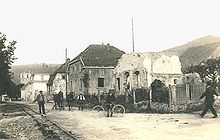Wattwiller
Wǎttwillr | |
|---|---|
 A general view of Wattwiller | |
| Coordinates: 47°50′13″N 7°10′51″E / 47.8369°N 7.1808°E | |
| Country | France |
| Region | Grand Est |
| Department | Haut-Rhin |
| Arrondissement | Thann-Guebwiller |
| Canton | Cernay |
| Intercommunality | Thann-Cernay |
| Government | |
| • Mayor (2020–2026) | Mathieu Ermel[1] |
| Area 1 | 13.61 km2 (5.25 sq mi) |
| Population (2021)[2] | 1,668 |
| • Density | 120/km2 (320/sq mi) |
| Time zone | UTC+01:00 (CET) |
| • Summer (DST) | UTC+02:00 (CEST) |
| INSEE/Postal code | 68359 /68700 |
| Elevation | 266–1,121 m (873–3,678 ft) (avg. 360 m or 1,180 ft) |
| 1 French Land Register data, which excludes lakes, ponds, glaciers > 1 km2 (0.386 sq mi or 247 acres) and river estuaries. | |
Wattwiller (French pronunciation: [vatvilɛʁ] ; Alemannic German: Wǎttwillr; German: Wattweiler) is a commune in the Haut-Rhin department of the Grand Est region, which lies in the north-eastern part of France.

Located near the Vosges mountain rocky spur of Hartmannswillerkopf, Wattwiller was a strategic village in the Alsace, and suffered attacks in or near it during the Thirty Years' War and in both World Wars.
Nowadays Wattwiller is best known for its mineral water. Wattwiller is also located on the Alsace Wine Route.
-
Mineral water plant
- ^ "Répertoire national des élus: les maires" (in French). data.gouv.fr, Plateforme ouverte des données publiques françaises. 13 September 2022.
- ^ "Populations légales 2021" (in French). The National Institute of Statistics and Economic Studies. 28 December 2023.




